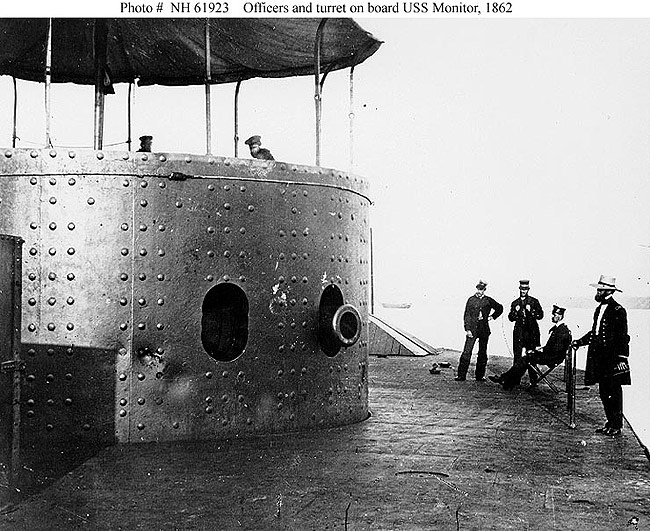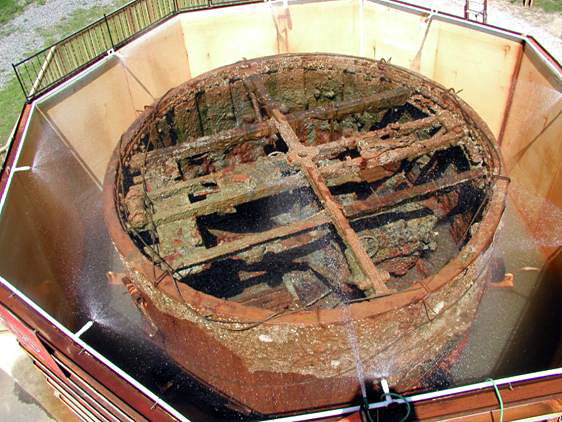The Monitor's Rotating Gun Turret
When constructed in 1862, the USS Monitor's rotating gun turret was the first of its kind. The gun turret served the Monitor well during the Battle of Hampton Roads, which took place at the mouth of the James River in Hampton Roads, Virginia. The turret was recovered in 2002, and is now undergoing conservation at The Mariners' Museum in Virginia.
The Monitor crew poses with the ship in 1862

The Monitor crew poses with the ship in 1862. Note the dents in the Monitor's turret sustained during the Battle of Hampton Roads. Image courtesy of the Naval Historical Center.
The revolving gun turret is the most famous feature of the USS Monitor. While the ship's designer, John Ericsson, was not the first to envision a revolving turret, his design for the Monitor was the first completed turreted naval vessel to be built.
The turret is 21 1/2 feet in diameter and nine feet tall. It was constructed of eight one-inch-thick iron plates that, with the exception of the first two layers, were bolted together so that they could be easily replaced if needed. It weighed about 120 tons and was able to rotate with the help of two steam engines that used a crank to turn four gears.
The position and shape of the turret on the Monitor led to it being referred to as a "cheesebox on a raft."
Historic Reference
Due to the threat that the CSS Virginia, a Confederate ironclad built from the burned hull of the USS Merrimack, posed to the federal fleet at Hampton Roads, Virginia, the Monitor was ordered to Hampton Roads in early March 1862. The Union ironclad arrived on the evening of March 8, just in time to see the results of the havoc and destruction caused by the Virginia on the Union wooden frigates Cumberland and Congress. The steam frigate USS Minnesota had run aground in Hampton Roads and the Monitor was ordered to protect her since the Virginia was sure to return on March 9.
When the Virginia steamed out to finish off the Minnesota the next morning, she was met by the Monitor. Despite the Virginia's much larger size, the Monitor demonstrated the advantages of a rotating gun turret over traditional broadside guns. The two vessels frequently bombarded each other at point-blank range over the course of four hours with no substantial damage to either vessel. However, a shell exploded in the view-port of the Monitor's pilot house, temporarily blinding Captain John Worden.
The Monitor steamed off into shallow water, where the Virginia could not follow, to assess the captain's wounds and damage to the ship. The Virginia's captain, assuming that the Monitor was leaving the battle withdrew in supposed victory. When the Monitor returned to resume the engagement and found the Virginia gone, her crew also assumed victory. Although there was no clear victor in the battle, the Monitor succeeded in preventing further destruction to the Union blockade.
Artifact Recovery
When the Monitor was found in 1973, the turret was upside-down under part of the hull. In order to bring it to the surface for conservation and display, a large portion of the ship's stern hull structure had to be removed. Once it was exposed, the turret was carefully brought to the surface and then transported to The Mariners' Museum in 2002.
The turret was carefully placed in a specially designed conservation tank where it is now undergoing a 12- to 15-year conservation process so that it can eventually be displayed. The public can watch the conservation process as part of The Monitor Center tour at The Mariners' Museum.
- Location: The Mariners' Museum, Newport News, Virginia
- Recovery: 2002, after a 45-day recovery expedition
- Material: Iron
- Notable Features: Some large dents to the exterior iron plates are visible signs of cannon balls bouncing off during the Monitor's encounter with the CSS Virginia during the Battle of Hampton Roads.
Related Web Sites:
Monitor National Marine Sanctuary
National Marine Sanctuary Program
The Monitor Center at The Mariners' Museum
Works Consulted:
Monitor National Marine Sanctuary. (1994). A look at the Monitor National Marine Sanctuary: Past, Present and Future.
Monitor National Marine Sanctuary. (2005). Monitor National Marine Sanctuary factsheet.
(top)

 George S. Geer Letters: Life Aboard an Ironclad
George S. Geer Letters: Life Aboard an Ironclad The Monitor's Rotating Gun Turret
The Monitor's Rotating Gun Turret The Monitor's Cannons
The Monitor's Cannons The Monitor's Anchor
The Monitor's Anchor The Monitor's Propeller
The Monitor's Propeller The Red Lantern
The Red Lantern Silverware from the Monitor
Silverware from the Monitor The Monitor's Engine and Register
The Monitor's Engine and Register Condiments and Bottles
Condiments and Bottles Monitor Photomosaics
Monitor Photomosaics